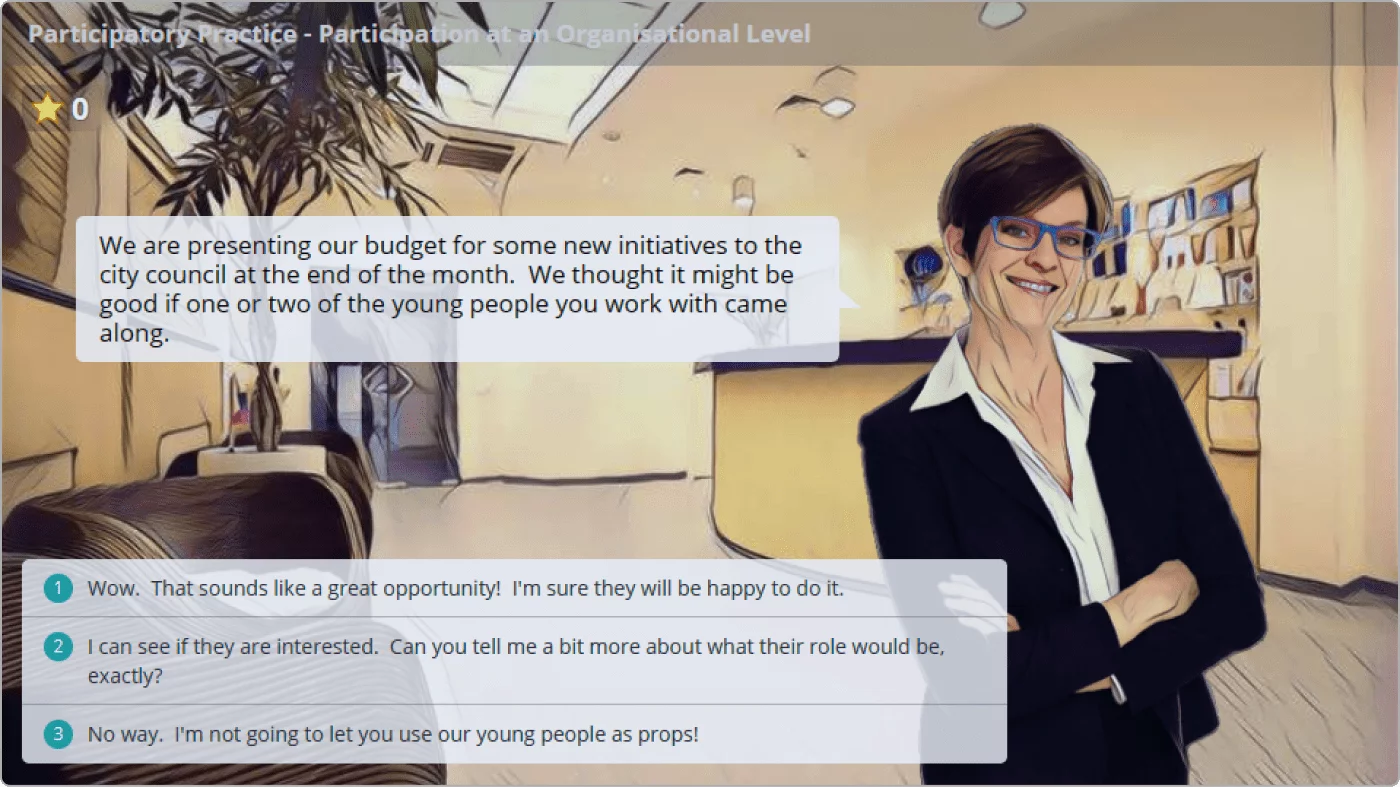How Sonata Learning Develops Mission-Critical Training with iSpring

Sonata Learning provides L&D consulting and content development services to a wide variety of clients all over the world from businesses and government institutions to NGOs and nonprofits.
Emil Heidkamp, founder and senior learning strategist at Sonata, shared how iSpring helps create effective training materials to address their clients’ mission-critical performance needs.
Sonata Learning background and projects
Emil Heidkamp, founder and senior learning strategist at Sonata Learning
At Sonata Learning, we help our clients translate their expertise into learning programs. We develop course materials and training programs for manufacturing, finance, government, energy, agriculture and other sectors, but our passion is working with mission-driven humanitarian NGOs and nonprofits.
Usually our clients receive funding from donors like the Gates Foundation, the World Bank, the European Union, USAID, or other parties to address public health, social or environmental issues around the world. For these projects they need to train up their employees, partners, volunteers, or educate the general public.

Learning modules for operators of textile mills in China
To give a concrete example, we developed a program to help operators of textile mills in China improve water and resource efficiency. For that project, we created eLearning modules reviewing both the environmental and economic benefits of properly insulating equipment and reusing water in different processes rather than disposing of it after a single use. We were able to embed these beautiful 4K videos that were shot on location, plus interviews with staff, alongside animated diagrams and interactions. They turned out quite lovely.
How we create content with iSpring Suite
We develop all our slide-based learning with iSpring Suite. We appreciate the fact that iSpring is a PowerPoint add-in because that makes it easy for us to pass the training content around among our team. A project team usually consists of two people: an instructional designer and a graphic designer, but depending on the scope of the project, there may be more people involved.
We appreciate the fact that iSpring is a PowerPoint add-in because that makes it easy for us to pass the training content around among our team.
An instructional designer creates the substance of the course from an adult learning perspective. They read through the client’s source documents and interview their subject matter experts, then create the scripts, the overall flow, and the structure of the course.
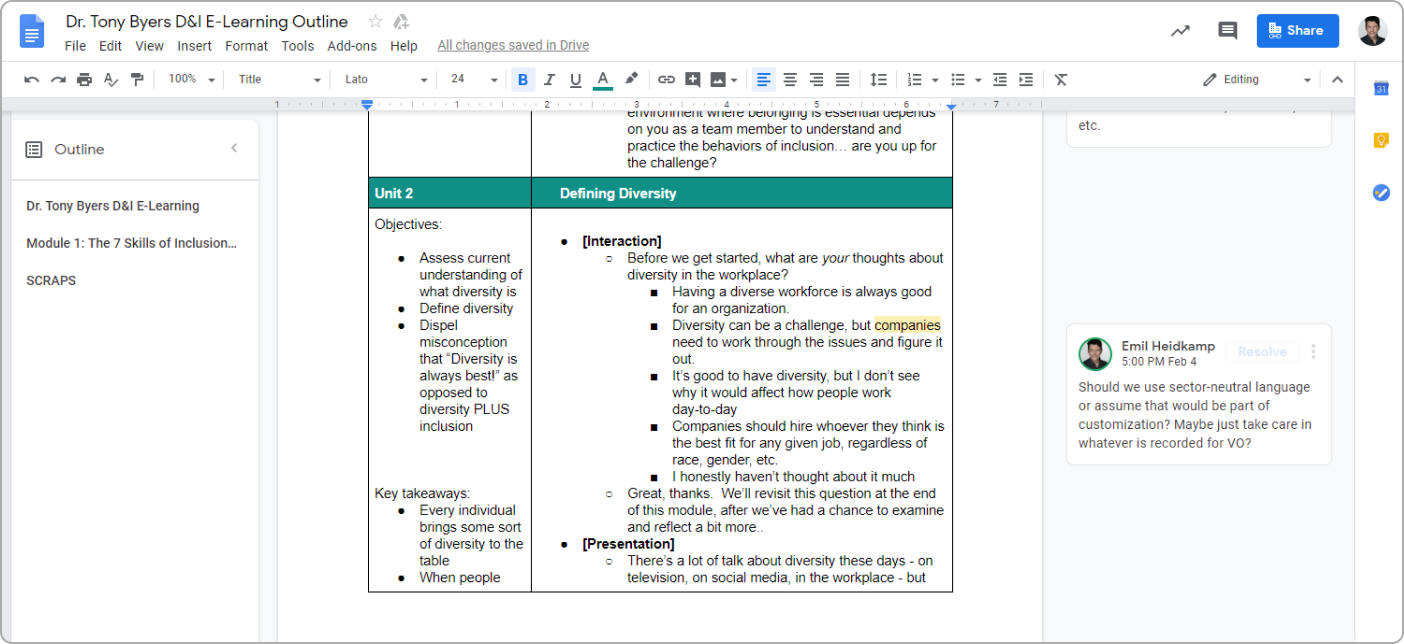
Course outline example
Once the script is done, the graphic designer creates a visual presentation and animation. We try to adhere to Google’s material design guidelines in our presentation approach: we don’t clutter up the screen with text, we let audio and imagery complement each other and not compete for attention, etc.
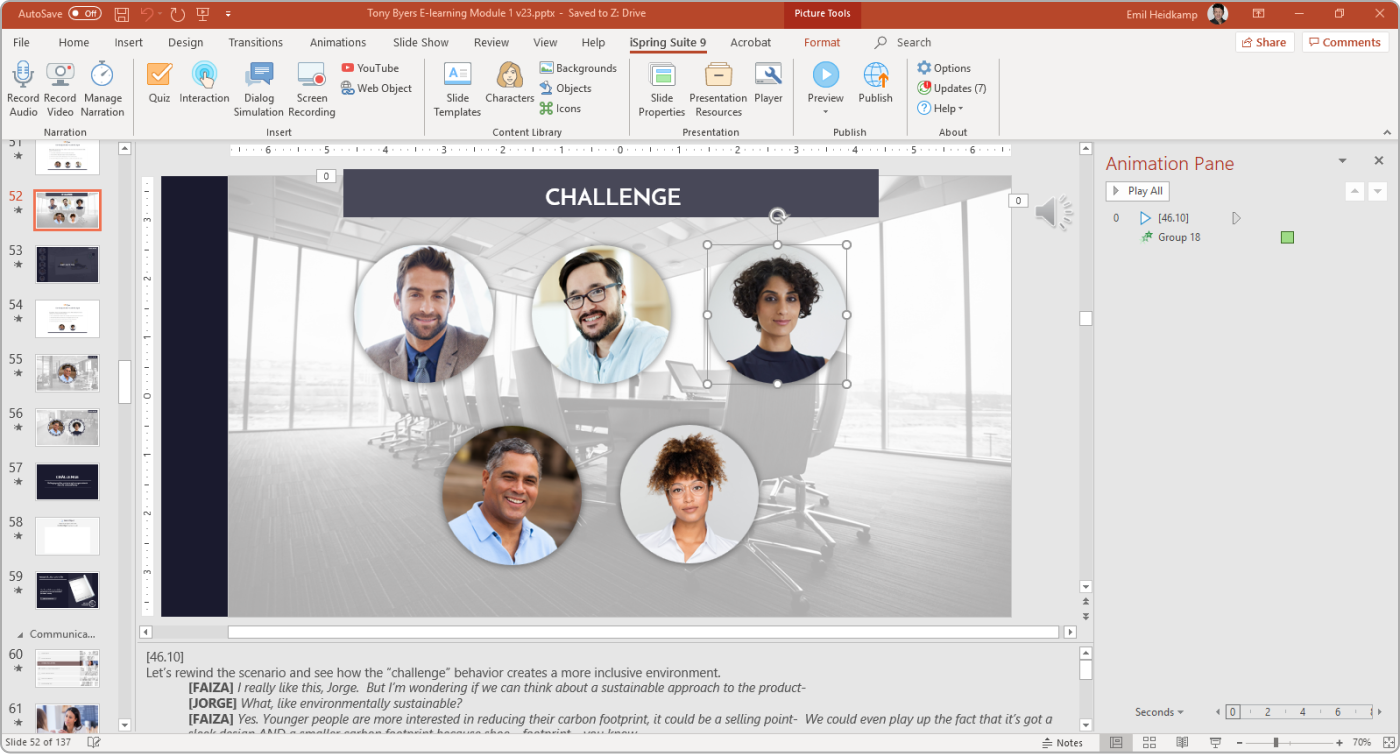
Fine-tuning visual design in PowerPoint
The Terre des Hommes case: Building interactive training materials on a sensitive topic
A good example of how iSpring Suite helps us create effective training content is this recent project we did for an international organization called Terre des Hommes. For this project, we were developing eLearning modules for social workers who help children and young people who have been abused or sexually exploited.
The Terre des Hommes experts had developed a set of recommendations and best practices to help make young people feel very involved, engaged, and in control of the process of their treatment and recovery. Initially, the client just handed us their classroom slide deck and said, “Take this and add some narration and quizzes,” but we sat down and worked with them to design an interactive learning experience that took full advantage of everything the eLearning format — and iSpring in particular — has to offer.
We worked with the client to design an interactive learning experience that took full advantage of everything the eLearning format — and iSpring in particular — has to offer.

The Terre des Hommes project: eLearning modules for social workers
The client also mentioned they did lots of role plays and exercises in their live workshops but thought that was impossible to re-create in eLearning. When we showed the client iSpring TalkMaster’s interactive dialogue simulations, they were very excited.
Using simulations to help social workers practice different scenarios
Because the subject of the course is very sensitive, we were facing a number of challenges while developing the content.
The first challenge was that, due to the nature of the content, the client would not allow the use of images of actual young people in this course. It didn’t matter if they were models in stock photos who signed releases — the client didn’t want any photographs.
To work around this restriction, we took photos of real people and used an app called Prisma to make them look like hand-drawn illustrations, then uploaded them to iSpring.
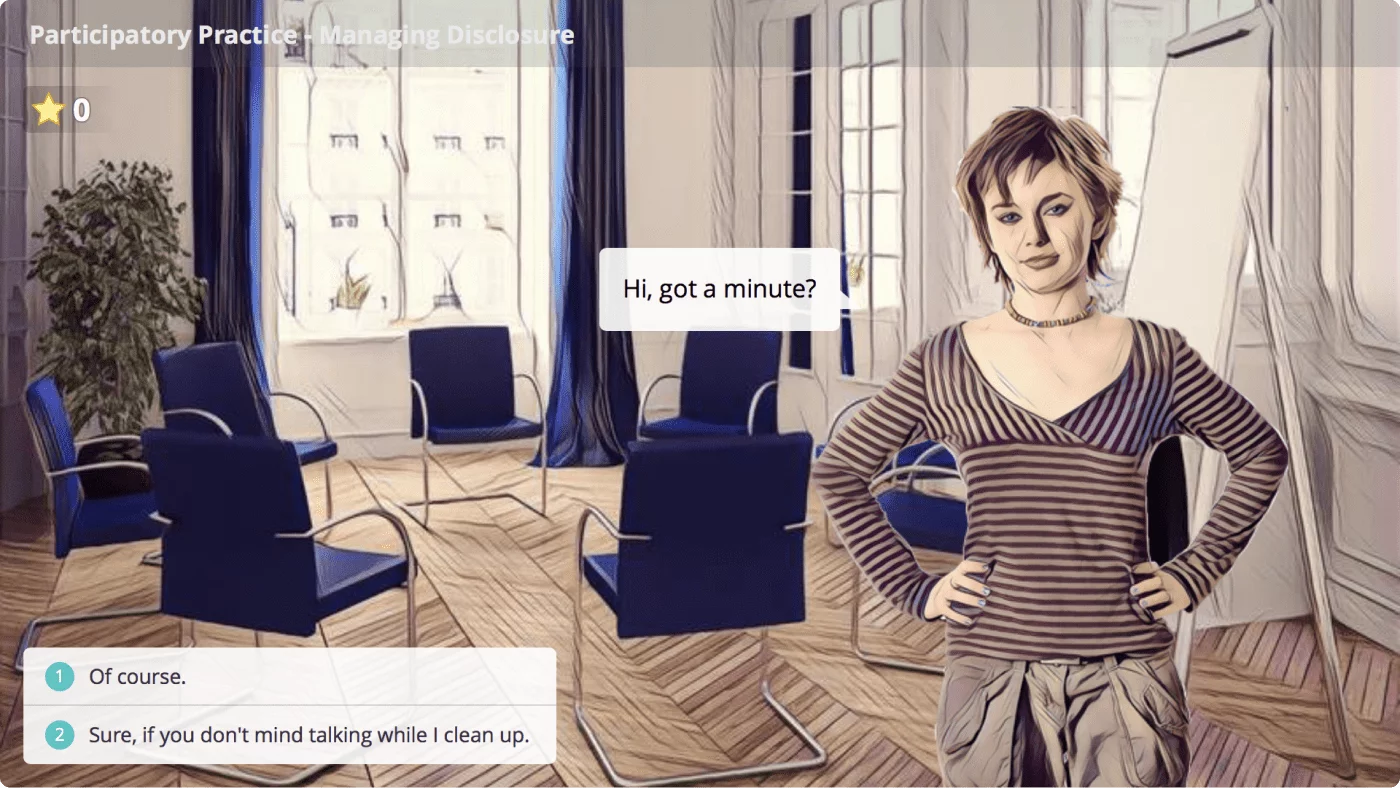
Using hand-drawn characters in dialogue simulations
Challenge number two was making sure that the situations we chose to depict were realistic and representative of the experiences that these social workers have with young people every day.
We actually immersed ourselves in a lot of YouTube footage posted by the types of young people these organizations work with to get a sense of what they talk about, especially about their feelings and whatnot.
We made sure the dialogue in the interactions reflected their speech patterns, even coarse or foul language. At first, we were worried that the client was going to censor it, but they actually said the social workers taking the course appreciated the realism.
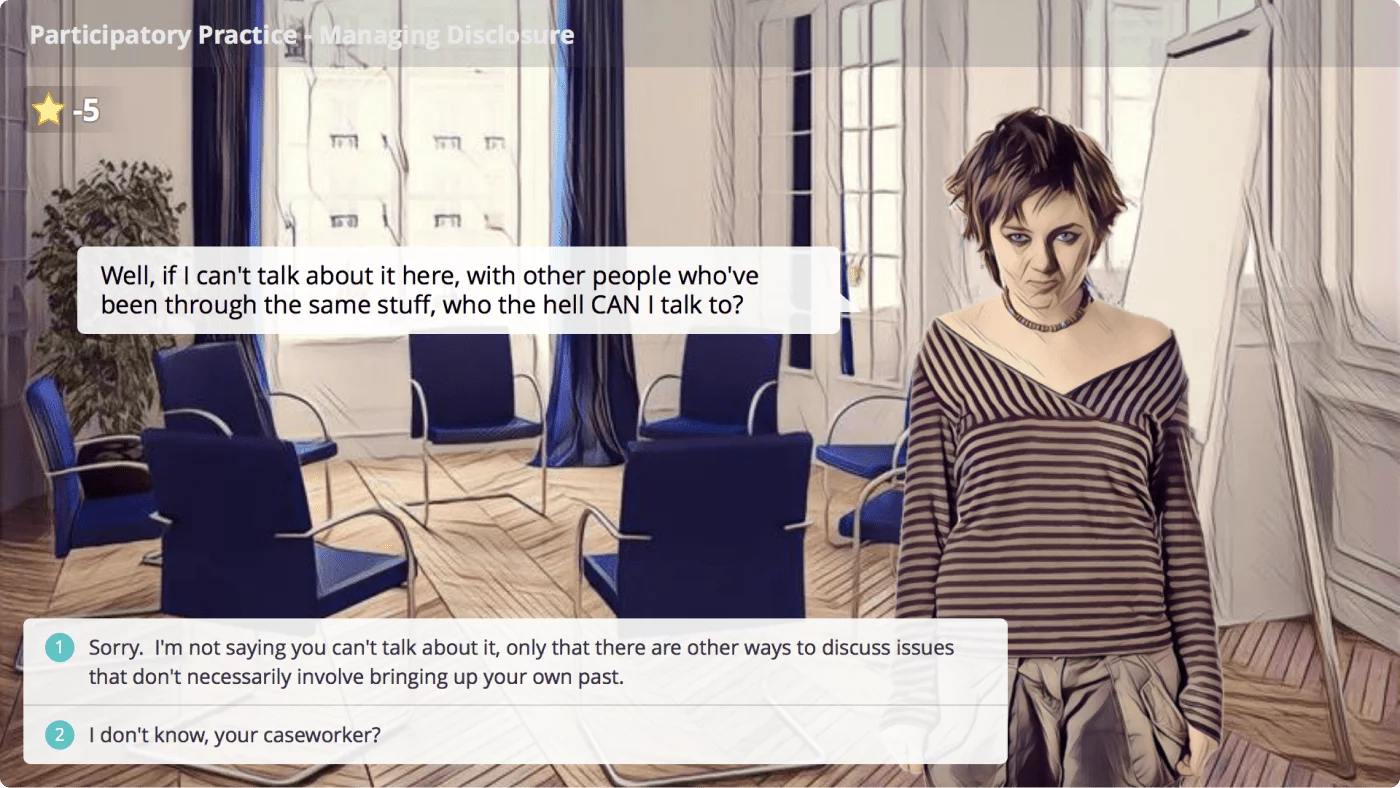
Reflecting speech patterns of the young people to make dialogues more realistic
And then the final thing was that we made sure the interactive scenarios always offered a path of forgiveness. Even if a learner made one misstep, unless it was an extremely egregious error, we didn’t immediately stop the interaction. We always had the character respond in a way where the learner could say something to recover.
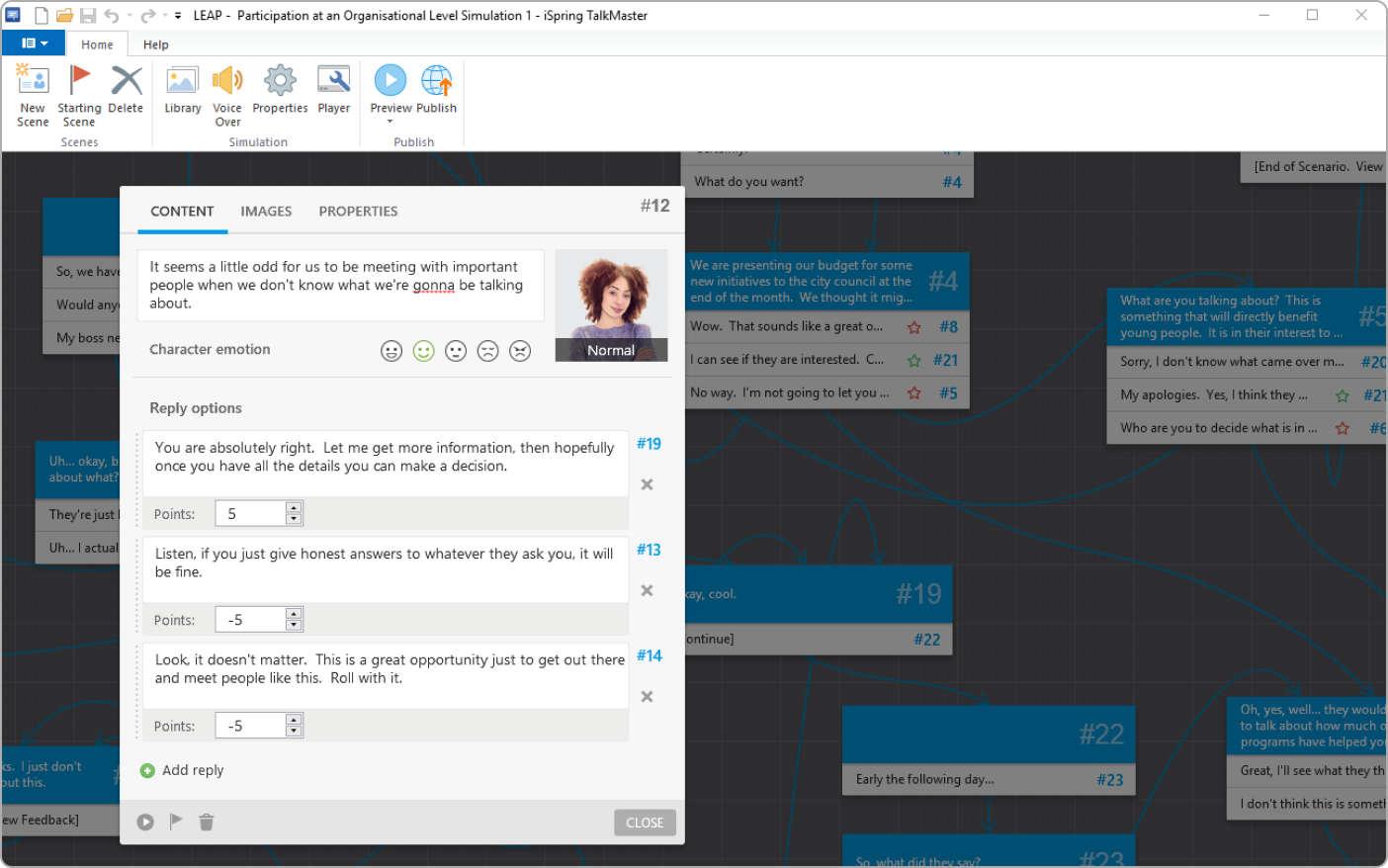
Making sure there’s a path of forgiveness in every branch of the dialogue
Inserting videos to make the content more relatable
In addition to having dialogue simulations, we also used iSpring to embed Vimeo videos from social workers in different cities who had successfully applied the skills and concepts from the course in practice. This helped us reinforce how some of the concepts play out in the real world, making the content more relatable.

Using real videos to make content relatable
Using quizzes and surveys to improve knowledge retention
Most people’s default approach to quizzes in eLearning is to show a few slides, then have a multiple choice question to make sure learners were paying attention and remembered the content on a basic level. But there’s so much more you can do with quizzes and surveys to engage the learner.
One of our favorite approaches is to have the narrator introduce a concept over the course of a few slides, then there’s an embedded quiz, but instead of stopping the flow of the presentation, we have the narrator read the question as if they were a teacher casually asking students a question in class — very conversational and natural.
Half the time, we don’t even make it a graded question. Rather, we use ungraded survey questions, and the narrator just asks for the learner’s opinion, with a realistic range of possible responses (including skeptical or sarcastic responses) and no right or wrong answers. Then we’ll have audio feedback to make it seem as if the narrator is responding in a natural, conversational way to what the learner just “said”.

Using non-graded questions to keep quizzes conversational and natural
Several of our clients have remarked at how this makes the whole experience feel less like taking a test on a computer and more like having a conversation with a human instructor. But, at the same time, we’re capturing all the responses, which can often provide valuable insight into the audience’s attitudes and understanding of the subject matter.
By leveraging the features of iSpring, we delivered an experience that kind of shocked the client with how rich and interactive the courses were. Judit Nemeth-Almasi, the Deputy Head of the Regional Office in charge of the project at Terre des Hommes, said she was impressed by how we managed to create modern, visually appealing and instructionally sound courses, and one of her colleagues went so far as to call the modules “works of art.”
Most importantly, the social workers who used the courses said that they were extremely helpful and really felt like their actual day-to-day work.
By leveraging the features of iSpring, we delivered an experience that kind of shocked the client with how rich and interactive the courses were.

